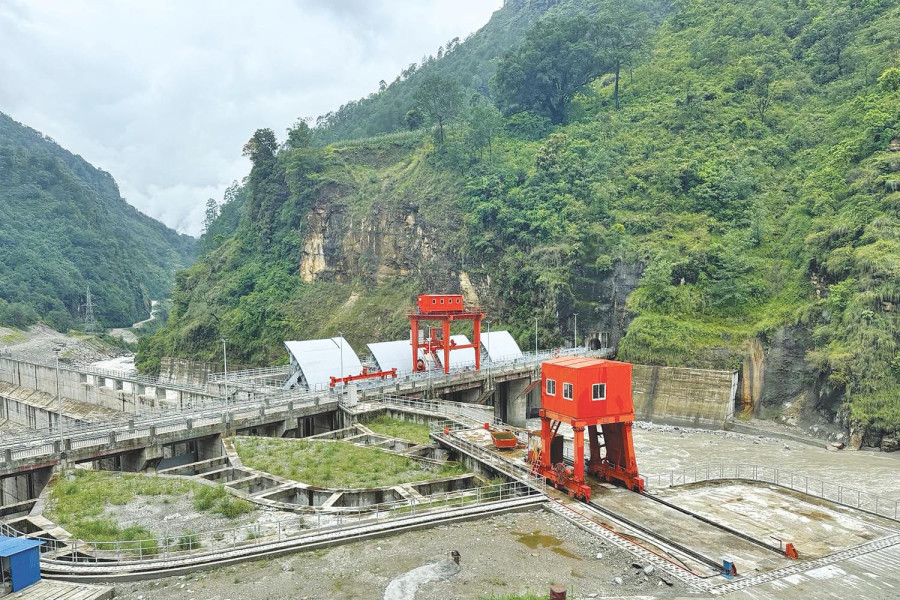Money
102MW Middle Bhotekoshi project close to electricity generation
Started in 2013, the Sindhupalchok project has become one of the longest in the works.
Post Report
The much-delayed 102MW Middle Bhotekoshi hydropower project has reached the electricity generation stage, with project officials expecting to supply to the grid within a month.
The four-year project in the Sindhupalchok district, developed by Madhya Bhotekoshi Jalavidyut Company Limited, a Chilime Hydropower Company Limited subsidiary, started in January 2013 and has had one of the longest hydel construction periods in Nepal’s history.
A team led by State Minister Purna Bahadur Tamang and Kulman Ghising, managing director of the Nepal Electricity Authority, visited the project site on Saturday and instructed the project officials and contractors to produce power within a month.
According to project officials, two kilometres of the 4 km transmission line connecting the power station’s switchyard at Barhabise Municipality 5 to the NEA substation in Barhabise Municipality Ward 3 has been completed following an August agreement with the local residents.
The locals delayed the construction of power lines by 14 months. The dispute was settled after the project agreed on appropriate compensation for land affected by the transmission line.
Energy Minister Deepak Khadka, along with State Minister Tamang, the energy secretary, and power utility chief Ghising, reached an agreement with the locals on August 30 to speed up the transmission line construction.
According to project officials, the construction of the 220 kV single-circuit transmission line is expected to be completed before Dashain.
Officials said the dam is now being tested. The main tunnel, measuring 7.12 kilometres, was filled with water for testing in mid-March last year. When a leakage was detected, repairs were made to a section of the tunnel.
Now, the tunnel has been cleaned, and the project plans to refill it in 15 days. Filling the reservoir will allow engineers to test the dam’s structural integrity and identify potential issues or leaks.
According to the project, civil works at the power station have been completed, and the dry testing of the electromechanical equipment is ongoing. Weight tests will start once water flows through the tunnel.
The officials said that if things go as planned, all remaining works will be completed within a month for power generation.
A temporary arrangement is in place to evacuate electricity from the Middle Bhotekoshi project.
Power will be delivered to the Barhabise substation via a 200 kV transmission line, then to the 132 kV line for distribution.
Shiva Shree Hydropower, the 22MW Upper Chaku A Hydropower Project promoter, is working on the 132 kV transmission line connecting the Barhabise substation. It aims to complete the facility before Dashain.
The 102MW project’s survey licence for power generation was awarded on April 8, 2011, and the connection agreement for power evacuation was signed with the Nepal Electricity Authority on August 25, 2011. The power purchase agreement (PPA) was signed on November 14, 2011.
Likewise, a tripartite loan agreement between the Employees Provident Fund, Chilime Hydropower Company Limited and the company was signed on December 8, 2011.
The Civil and Hydromechanical work contract was awarded to Guangxi Hydroelectric Construction Bureau, and the Electro-Mechanical Contract was to Andritz Hydro Private Limited in association with Trade Link International.
Similarly, the transmission line works contract was awarded to Urja-AC JV on July 27, 2018.
Construction work on the 102MW project in Sindhupalchok began in early 2014, and it was expected to start churning out electricity by December 2016.
However, the project missed the completion deadlines due to natural disasters, land compensation issues and delays by the civil and hydro mechanical contractor Guangxi Hydroelectric Construction Bureau.
The completion deadline for the run-of-the-river project was extended till November 2020.
The estimated cost, including interest, of construction, was Rs12.83 billion. However, due to delays, the cost has gone above Rs16 billion without adding interest payments.
The run-of-the-river type project has been built with 50 percent debt financing of the Employees Provident Fund, equity investment by Chilime Hydropower Company and public shares.
The project’s contribution to the national grid will see a huge drop during the dry season. It has a higher-than-average per megawatt cost of Rs137 million, as per 2018 cost reports.
The project is expected to generate 542.2 million units of electricity annually. As per the agreement, the power utility will purchase the electricity at Rs8.40 per unit in the dry season or in winter, and Rs4.80 per unit in the peak season or in monsoon.
The annual revenue from the project has been estimated at Rs2.8 billion.




 6.12°C Kathmandu
6.12°C Kathmandu













